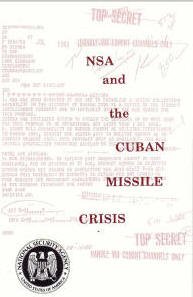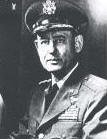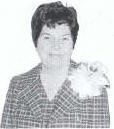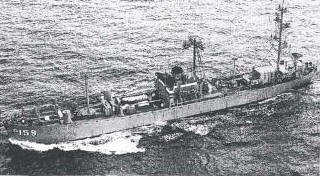
For further information or additional copies, contact the Center for Cryptologic History, National Security
Agency, Fort George G. Meade, Maryland, 20755-6886, ATTN: S542.
PRELUDE
The Cuban Missile Crisis of October 1962 was one of the turning points of the Cold War between the United
States and the Soviet Union. At that time the two superpowers came close to war, possibly with nuclear weapons;
after it, both countries began to seek ways to adjust to each other, in particular, to prevent the use of nuclear
weapons.
The events of the Cuban Missile Crisis demonstrated the maturity of the U.S. intelligence community, especially
in its ability to collect and analyze information. The crucial roles of human intelligence (HUM~NT) and
photographic intelligence IPHOTINT) in the Cuban Missile Crisis have been known from the beginning. Documents
declassified and released in 1998 now reveal that signals intelligence (SIGINT) also played an exceedingly
important part in managing the crisis.
It should be said at the outset that signals intelligence did not provide any direct information about the Soviet
introduction of offensive ballistic missiles into Cuba. However, in the more than two years before that fact was
known, SIGINT analysts thoroughly studied the Cuban military buildup. Once the offensive missiles were discovered,
SIGINT provided direct support for day-to-day management of the crisis. This is the story of SGINT in the Cuban
Missile Crisis.
When Fidel Castro took power in Cuba by overthrowing the previous dictator, Fulgencio Batista, he was hailed as a
liberator by the Cuban people themselves and became a hero to the American people as well. However, Castro soon
took actions inimical to American interests and aligned his country publicly with the Soviet Union. The U.S.
public and government were gravely concerned about the creation of a communist state and member of the Soviet Bloc
only 70 miles from their southern shores; this problem became a major focus of the new Kennedy administration when
it took office in January 1961.
 In
response to the potential threat and the administration's interest in it, the U.S. intelligence community began a
new focus on information about Cuba. The National Security Agency also beefed up its coverage of Cuba and Soviet
support for the island nation. In
response to the potential threat and the administration's interest in it, the U.S. intelligence community began a
new focus on information about Cuba. The National Security Agency also beefed up its coverage of Cuba and Soviet
support for the island nation.
In Havana, one of the consequences of its alignment with the USSR was fear that the United States might
intervene against the new Cuban government. This fear materialized in later 1961 when Cuban exiles, trained by
America's CIA, staged an invasion of Cuban territory at the Bay of Pigs. Although the invasion was quickly
repulsed, it intensified an arms buildup that was already under way.
THE CUBAN ARMS BUILDUP
The signing of agreements with the Soviet Union and Czechoslovakia in mid-1960 was followed by a secret arms
build up in Cuba sponsored by the Soviets and their satellites. Early indications of that buildup came from
signals intelligence - the intercept of Soviet and Soviet Bloc communications that carried information related to
the arms supply operations. Beginning late in 1960 and extending through 1961, NSA intercepted messages concerning
Soviet ships headed for Havana. The cargo manifests were suspiciously blank, indicating that what they carried was
more than just palm oil or farm equipment.
For example, early in 1961 the Nikolay Burdenko arrived at the Cuban port of Mariel. The unloading operation
was highly secret, but NSA caught Cubans discussing the arrival of tanks. It was hardly an innocent delivery.
As vessels poured forth their cargoes, the Cubans took extra precautions to keep them secret. They kept gawkers
away from the wharf, unloaded at night, even prohibited over-flights of the area while the unloading was taking
place. Deliveries rolled away from the pier under black canvas and heavy guard. The United States government knew
this from NSA intercepts of Cubans discussing the procedures.
 The
agreement with the Czech government in June of 1960resulted in additional deliveries of small arms and ammunition,
light aircraft, military vehicles, and equipment for military factories. Even more ominous was the training of
Cuban pilot in Czechoslovakia. American intercept operators began to hear Spanish along with the usual mix of
Slavic tongues coming from airfields in Czechoslovakia. As early as- the fall of 1960, Cuban pilots were being
trained in piston engine trainers; later evidence showed that the training included jet aircraft. Thus it came as
no surprise when, in mid-1961, CIA sources got wind of the imminent arrival of Soviet combat d transport Waft,
including the light bomber IL-28 and the state-of-the-art MiG-15s, 178, and 1%. It was clear by then that a major
upgrade of the Cuban air force was in progress. The
agreement with the Czech government in June of 1960resulted in additional deliveries of small arms and ammunition,
light aircraft, military vehicles, and equipment for military factories. Even more ominous was the training of
Cuban pilot in Czechoslovakia. American intercept operators began to hear Spanish along with the usual mix of
Slavic tongues coming from airfields in Czechoslovakia. As early as- the fall of 1960, Cuban pilots were being
trained in piston engine trainers; later evidence showed that the training included jet aircraft. Thus it came as
no surprise when, in mid-1961, CIA sources got wind of the imminent arrival of Soviet combat d transport Waft,
including the light bomber IL-28 and the state-of-the-art MiG-15s, 178, and 1%. It was clear by then that a major
upgrade of the Cuban air force was in progress.
One problem shared by intelligence a6alysts and administration policymakers alike was the nature of the
military deliveries. Most of the military equipment could be described accurately as defensive, but much of it
could also b used in taking the offense. The primary question for Americans was: would the Soviets introduce
offensive missiles into Cuban territory?
Improvements to Cuban defensive capabilities continued to characterize Soviet deliveries. In May of 1961 NSA
discovered references to shipborne radar, and in June to radars associated with antiaircraft guns. Cubans
chattered over the radio abut "highly unusual aircraft" and impending training on various unspecified "Russian
equipment."
Military deliveries increased in 1962 and, along with them, Soviet attempts to conceal them. An NSA report in
July indicated that Soviet vessels calling on C u b ports were making false port declarations and declaring less
than the known cargo-carrying capacity. By late August NSA noted that there had already been fifty-seven voyages
in a little over a month, and some ships were on their second voyage in that period of time.
THE CRISIS GROWS
Cuban air defenses improved at an accelerating pace. In May, SIGINT reports had the first indication of
airborne fire control radar on MiG-17 and MiG-19 planes. Ground radar activity became heavier all over the island.
By early summer, NSA analysts concluded that the Cubans were putting together an air defense system copied from
the Soviet model. Equipment, training, and procedures were the same. In fact, by early fall NSA was listening to
Russian ground controllers speaking in heavily accented Spanish to Cuban pilots.
Confronted with American concerns about this military buildup, several Soviet spokesmen, including the foreign
minister, assured the U.S. government that the military equipment sent to Cuba was for defense only. Offensive
weapons would not be introduced.
In August and September 1962, Soviet deliveries surged to the highest levels ever seen. In August, CIA analysts
saw the first indications of an ominous new development, the construction of SA-2 surface-to-air missiles. These
represented a new turn in the arming of Cuba - such weapons could shoot American military aircraft out of the
skies, including CIA'S U-2 photographic reconnaissance planes. It had been an SA-2 that had shot down Francis Gary
Powers' U-2over the Soviet Union two years earlier.
SA-2s, moreover, were very expensive. Was the Soviet purpose to keep US. reconnaissance aircraft out of Cub,
and if so, why? John McCone, Director of Central Intelligence, came up with an answer that no one wanted to bear:
SA-2s were on the island to deny the United States the capability ta see the construction of offensive missile
installations. Others in the defense and intelligence communities dissented from this opinion.

John McCone Director of Central Intelligence during the Cuban Missile Crisis
Human sources and photography could spot SA-2s, but signal intelligence would provide the first indicator of
their operational status. On September 15, NSA reported the first operation of a Spoon Rest radar, associated with
the SA-2. The SA-2was operational and could shoot down a U-2. Subsequent over-flights would be at risk.
Other parts of the Cuban air defense system also matured in September. NSA reported that Cuban pilots,
previously trained in Soviet Bloc countries, frequently went up to challenge American aircraft buzzing the
periphery of the island. Cuban pilots practiced timed scrambles and performed border patrols whenever American
naval aircraft approached. Under the watchful eye of Russian GCI(Ground Controlled Intercept) controllers, their
procedures became coordinated and efficient. With the new MiG fighters, using Soviet originated ground control
procedures and Soviet weapons, Cuban pilots were becoming a potent defensive force. With the antiaircraft weapons
and surface-to-air missiles, American aircraft would approach Cuba at their peril.
On October 10, NSA reported that the Cuban air defense system seemed to be complete. They had just begun
passing radar tracking from radar stations to higher headquarters and to defensive fighter bases using Soviet
procedures. Their system, with Russians in advisory positions at every point, was ready for business. It was into
this defensive thicket that a CIA U-2 flew four days later. Although it survived, on October 25 another U-2 was
shot down.
At this point, on October 15 analysis of photographs taken on the U-2 flights revealed to the U.S. senior
leadership that the Soviet Union was preparing sites to install SS-4s, medium-range ballistic missiles. DCI
McCone, alone among the government's senior leaders, had been correct about Soviet intentions. President John F.
Kennedy secretly convened a series of emergency meetings ,of his senior military, diplomatic, and political
advisors, a grouping that became known as the Executive Committee, or ExCom, to seek ways of coping with this
ominous development.
As the crisis progressed, and the ExCorn considered a wide variety of diplomatic and military options, the need
for information on Cuba and the Soviet Union increased. All members of the U.S. intelligence community responded
splendidly.

Lieutenant General Gordon A. Blake, Director of NSA, July 1969 -May 1905

Mrs. Juanita Moody
THE NSA RESPONSE
At NSA, the response to the crisis was led by the director, Lieutenant General Gordon Blake, USAF. Blake had
become DIRNSA only three months before, but he had a strong background in communications and intelligence. Early
in his career he had been operations officer at Hickam Air Force Base in Hawaii, and was awarded the Silver Star
for gallantry during the Japanese attack on December 7, 1941. After a series of command and staff positions,
in1957 he became chief of the Air Force Security Service. Two years later he became vice commander and chief of
staff of the Pacific Air Forces, then chief of the Continental Air Command. In 1962, when Vice Admiral Laurence
Frost was unexpectedly transferred from his position as DIRNSA, Gordon Blake was selected as his replacement.
Much of the day-to-day - or minute-to-minute - burden fell on an element of the Operations organization headed
by Mrs. Juanita Moody. Mrs. Moody had begun her career as a cryptanalyst during World War I1 and had remained in
cryptology after the end of the war. Her office worked around the clock to reexamine older reports about the
status of Cuba's armed forces and produce current intelligence quickly. In addition to producing new reports and
summaries, Mrs. Moody found it necessary to give impromptu telephone briefings to senior military and political
decision makers, most of whom would call for information updates at any hour of the day or night.
Mrs. Moody later recalled how NSA responded as a team to the crisis, sometimes in unusual ways. At one point
General Blake came to her office to ask if he might be of any assistance to the effort there. She asked him to try
to get additional staff to meet a sudden need for more personnel. Shortly she heard him on the telephone talking
to off-duty employees, "This is Gordon Blake calling for Mrs. Moody. Could you come in to work now?" -
To ensure timely responses to unexpected needs by the consumers of SIGINT, General Blake established NSA's
first around-the-clock command center. General Blake also took responsibility for getting NSA's product to the
White House and interpreting its sometimes arcane indicators to the policymakers.

The USS Oxford
NSA had deployed a considerable capability around Cuba, including SIGINT collection from ground-based stations
and aircraft circling the periphery of the island, just outside Cuban territorial waters. The USS Oxford, a
specially configured SIGINT collection ship, nestled close to the Cuban coastline intercepting radio
communications from the island.
TOTHE BRINK
On October 22, President Kennedy appeared on television and announced the U-2 findings to an anxious public.
Despite assurances from the Soviet government that the buildup was defensive, he said, medium-range and
intermediate-range ballistic missiles had been introduced into Cuba. He called for their withdrawal or
elimination. As one measure to solve the crisis, he proclaimed a naval "quarantine" of Cuban ports to prevent the
introduction of additional Soviet armaments. Kennedy also warned that further actions might be needed if the
buildup of offensive weapons continued.
SIGINT collectors listened to the radio messages to and from the Soviet vessels on their way to Cuba. Would
they turn around, or would they challenge the U.S. Navy "quarantine" that the president had imposed on Cuba? A
cordon of U.S. Navy vessels awaited the Soviet cargo vessels in the Atlantic. Conflict between them, if it
happened, carried with it the possibility of escalation into wider war between the two superpowers.
THE FEVER BREAKS
The answer came the next day, from signals intelligence. A Navy SIGINT direction finding net in the Atlantic
located the Soviet ships by intercepting and triangulating messages that they were sending back to the Soviet
Union. The ships were stopped dead in the water, outside the ring of American naval vessels waiting for them. A
confrontation had been averted, one that might have precipitated war. The president, his cabinet, and the American
people could breathe a little easier.
Later, once the Soviets agreed to remove the ballistic missiles from Cuba, NSA reports also provided evidence
to the American government that the Communist Bloc also considered the crisis over.
Looking back on the Cuban Missile Crisis, it is clear that SIGINT, combined with other types of intelligence
such as photography and human sources, had pinpointed Cuba as a grave threat b the United States. The arms buildup
and the defensive improvements spelled trouble and focused the president and military leaders on the threat from
Cuba long before the crisis erupted. In the middle of crisis, the intelligence system gave the president the
information he needed to extricate the nation from its - most dire crisis since the end of World War If.
Thomas R. Johnson
David A. Hatch
May 1998
See the original
NSA and the Cuban Missile Crisis document here.
|




























 In
response to the potential threat and the administration's interest in it, the U.S. intelligence community began a
new focus on information about Cuba. The National Security Agency also beefed up its coverage of Cuba and Soviet
support for the island nation.
In
response to the potential threat and the administration's interest in it, the U.S. intelligence community began a
new focus on information about Cuba. The National Security Agency also beefed up its coverage of Cuba and Soviet
support for the island nation.  The
agreement with the Czech government in June of 1960resulted in additional deliveries of small arms and ammunition,
light aircraft, military vehicles, and equipment for military factories. Even more ominous was the training of
Cuban pilot in Czechoslovakia. American intercept operators began to hear Spanish along with the usual mix of
Slavic tongues coming from airfields in Czechoslovakia. As early as- the fall of 1960, Cuban pilots were being
trained in piston engine trainers; later evidence showed that the training included jet aircraft. Thus it came as
no surprise when, in mid-1961, CIA sources got wind of the imminent arrival of Soviet combat d transport Waft,
including the light bomber IL-28 and the state-of-the-art MiG-15s, 178, and 1%. It was clear by then that a major
upgrade of the Cuban air force was in progress.
The
agreement with the Czech government in June of 1960resulted in additional deliveries of small arms and ammunition,
light aircraft, military vehicles, and equipment for military factories. Even more ominous was the training of
Cuban pilot in Czechoslovakia. American intercept operators began to hear Spanish along with the usual mix of
Slavic tongues coming from airfields in Czechoslovakia. As early as- the fall of 1960, Cuban pilots were being
trained in piston engine trainers; later evidence showed that the training included jet aircraft. Thus it came as
no surprise when, in mid-1961, CIA sources got wind of the imminent arrival of Soviet combat d transport Waft,
including the light bomber IL-28 and the state-of-the-art MiG-15s, 178, and 1%. It was clear by then that a major
upgrade of the Cuban air force was in progress.



